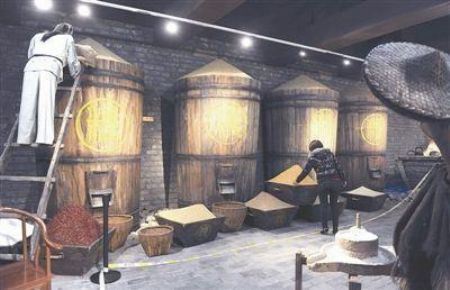| The Museum of Imperial Granary in the Ming Dynasty opened in Nanxincang on January 10. Here people can view the Beijing-Hangzhou Grand Canal free of charge, learn about the history of canal transportation and grain storage in imperial granary in the Ming and Qing dynasties as well as experience the life of being a granary head to grind the millstone and open the granary.

Surrounded by a bamboo forest, the small and delicate Suzhou garden appears, and a fleet of ships laden with grains moves upstream. The sound, light and electricity combine to simulate the winding of the Beijing-Hangzhou Grand Canal all the way long. When ships reach the dock of Tongzhou District, dockers shouldered the grain bags, and filled the handcarts. The scenery depicted in the Along the River During the Qingming Festival that hangs behind these dock workers shows the prosperity. Once visitors enter the museum, they will go through time and space to experience the whole process of canal transportation in the Ming and Qing dynasties.
"Through these methods that make the process realistic, visitors will have a deeper impression during the visit and learn the history of canal transportation." A staff member of the museum said, "Visitors can also enjoy other scenes, for example, visitors can walk on two small bridges to enjoy the beautiful scenery of Beijing-Hangzhou Grand Canal."
Apart from showing the process of transporting grains, the museum also demonstrates the way of storing grains in ancient times. The reporter found that the museum specially prepared five big grain silos that are about three meters high to simulate the scene at that time. “In ancient times, people had to climb ladders to put grains into the silos for storage, but it was easier to get grains out.” The staff member of the museum explained, "There is a gate at the bottom of every silo. As long as grain bags are directed at the gate, all people have to do is just open the gate directly." When the museum is under trail operation, visitors who are lucky enough can experience opening the granary personally, and bring grains back home.
There are many cultural relics in the museum, though they seem inconspicuous. A wind turbine during the Xuantong period that still works is among these cultural relics. The wind turbine can blow the impurities on the surface of grains away. A bamboo hat and a straw rain cape are hanging on the wall in the granary built 600 years ago, which is made of blue ricks and round wood. A millstone still works, and visitors can push the millstone to experience the hardships of ancient people.
What is worth mentioning is that the Museum of Imperial Granary in the Ming Dynasty is located at the place where the imperial granary in Ming Dynasty was situated, Nanxincang. During trial operation, the museum will open every day, and residents can visit the museum free of charge.
Source: CCTV.com
Editor: David |


